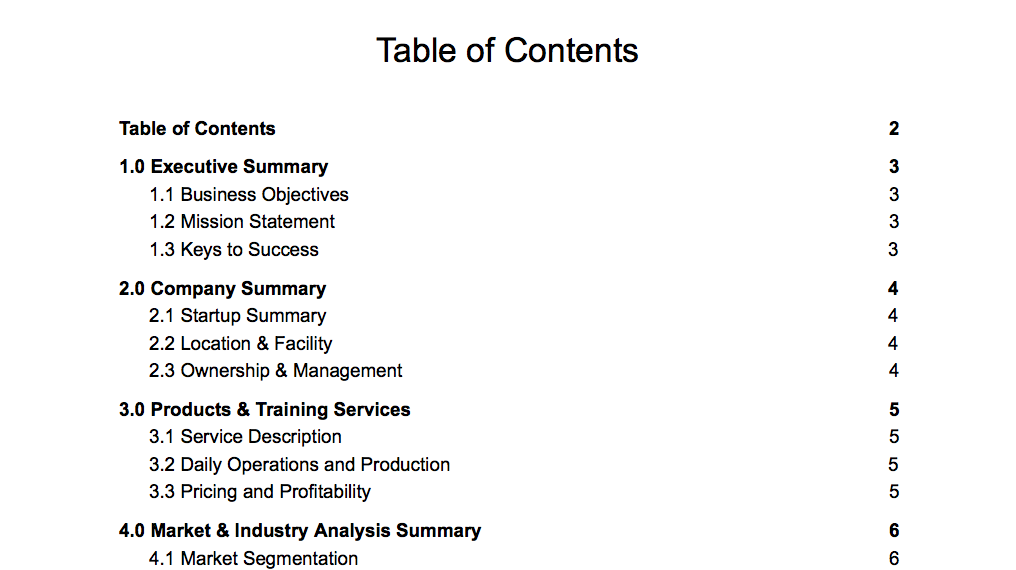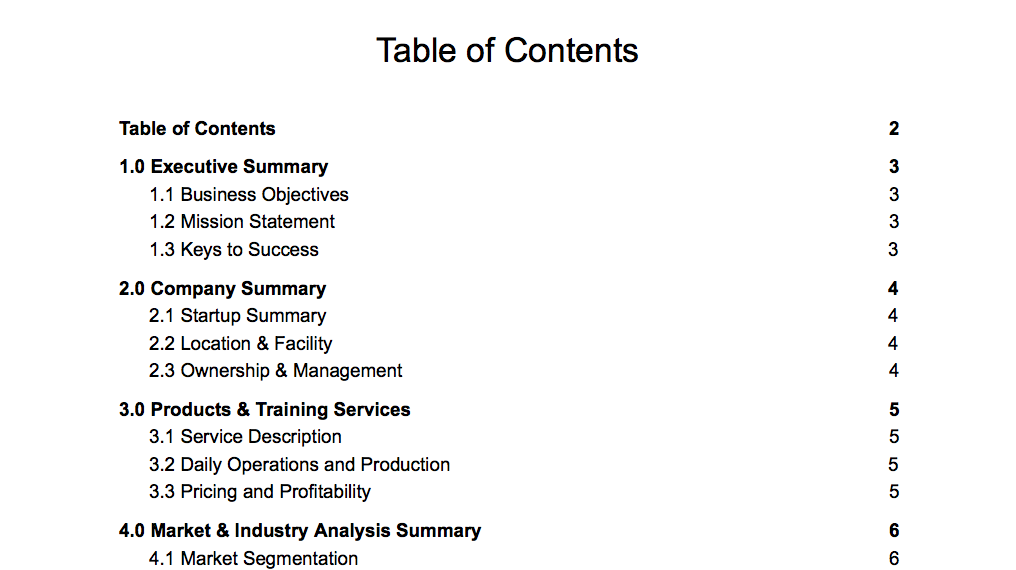A personal training business helps clients improve their fitness level. Learning how to start a personal training business is simple when you follow a step-by-step process beginning with research and a business plan. To help secure clients, build a personal brand. A full-time personal trainer can earn between $30,000 to $150,000 a year.
Before starting a personal training business, you should create a website to promote your business. When someone searches your name in Google, your website should show. A business without a website appears less credible. Dreamhost is an all-in-one website building platform. It can help you secure your domain name, obtain hosting, and create a website theme. Get started with Dreamhost today.
Here is a personal training business plan template you can use to keep your business on the right track:

Click a link to download the template; if possible, we recommend using Word because the Table of Contents update automatically as you as fill out the template
Word / Google Doc / PDF
Here’s how to start a personal training business in six steps.
1. Research Personal Training Business Ideas & Options
Before diving into your personal training business plan, it’s important to do research and think about your personal training business: What type of services will you provide? Who will you market these services to? What type of certifications will you obtain, and how much do they cost? What type of location do you want to work at? What equipment do you need to purchase to make that location effective?
What Kind of Personal Training Will You Provide?
There are several choices you will need to make about the personal training you provide. Will you specialize in a particular training, such as bodybuilding, high intensity, martial arts-related, or rehabbing injuries? Additionally, what demographics would you like to train? There are women, men, young athletes, seniors, and physically impaired individuals. Will nutritional guidance be part of your business? Is it going to be a full-time or part-time operation?
Becoming clear on the type of personal training you want to provide will guide the marketing, branding, and certification training you pursue. Generally, you shouldn’t want your training to be for everyone. Classic marketing advice is that if a product is for everyone, it’s for no one because the messaging doesn’t connect with anyone specifically.
“I consistently find that the busiest trainers are the ones who picked niches that were goal-oriented and/or problem-related. In Boston, the busiest trainers specialize in running coaching (solves the problem of bad running form), yoga training for runners (recovery training from running), cycling coaching (fixes slow speed due to strength imbalances), swim coaching (poor stroke form slows me down), and so on. Focusing on a niche not only makes a trainer stand out against the generalists but also helps build a referral network from other trainers who work with your ideal customer.”
―Giuseppe Frustaci, Founder, Stick Shift Driving Academy
Personal Training Certification
Certifications are important for personal trainers because they help build your knowledge base and add to your credibility. A popular certification is the National Academy of Sports Medicine’s (NASM) personal training certification (NASM-CPT), which costs anywhere from $524 to $1,499.
Additionally, there are several other certifications, like the American Fitness Professionals Association’s (AFPA) Senior Fitness Specialist Certification and Youth Fitness Specialist Certification. The AFPA’s certifications generally cost between $349 to $599.
All personal trainers should get certified in first aid, cardiopulmonary resuscitation (CPR), and automatic defibrillation (AED). You can find this training locally at health training companies, college recreation centers, the American Red Cross, and the American Heart Association. First aid, CPR, and AED training costs around $100.
Choose a Location
A positive of owning a personal training business is the ability to work at many different locations. You’re not restricted to working in a building that has a high overhead cost. As a personal trainer, you can train people in public areas, such as at a park or the beach. Additionally, you can meet clients in their own home gym or have them come to your house to workout.
Many personal trainers are independent contractors and rent out space in a local gym. Training online is also growing in popularity. Apps like Trainiac help people looking for online training. Marketing your services over the internet expands your potential customer base from local to worldwide.
Research Equipment
Once you know the type of training you plan to offer, and where it will take place, you can look into purchasing equipment. We recommend you purchase used equipment, which can cost about 40% to 60% less than new equipment. If meeting clients in their home for a training session, you may want to purchase basic equipment that can provide a quality workout, regardless of the equipment they have.
2. Write Your Personal Training Business Plan
Every personal training business, both full-time and part-time, need a business plan. A business plan is a strategic plan that helps you think through everything needed to make the business a success. Most importantly, it includes a section for financial projections, where you will use data to predict how much money the business will earn and expense over the next 3 years in business.
We created a personal training business plan template for you to use and customize. If possible, we recommend downloading the template in Microsoft Word format. We included a Table Of Contents to help you easily follow along with each section, but the actual page numbers change as you add more information to the template. To save the Microsoft Word document, open the document, click File and then Save As. Rename the document, and finish by clicking save.
The Google Doc is accessible but isn’t editable. To make the Google Doc editable, click on the Google Doc link to open the template, open your own Google Doc, and paste our version. The PDF is read-only and is a great way to get an overview of the business plan template.

Click a link to download the template; if possible, we recommend using Word because the Table of Contents update automatically as you as fill out the template
Word / Google Doc / PDF
Traditional vs Modern Business Plan
A traditional business plan is similar to an in-depth business report. If you’re seeking financing from a bank for a personal training gym, we recommend using a traditional business plan. The business plan template we created for you is designed for a traditional plan. Alternatively, a modern business plan is a leaner model that you can finish in less than an hour. Additionally, it tends to be more visual than a traditional plan.
A business model canvas (BMC), another name for modern business plan, is best for the average personal training business because it can be completed quickly. Compared to the traditional business plan, there are new sections, such as the Value Proposition (that tells what you provide clients) and the Customer Relationships (detailing how you maintain contact with clients outside of the training session).

The business model canvas features the Channels section, which is about where and how you reach your customers
Competitor Analysis
In a business plan, you need to include information about your competitors. For the competitor analysis, list your top five competitors that are located within a five-mile radius―expand if needed―of your business. For each of the five competitors, list how far they are from your location. Include each competitor’s advantages over your business, and the advantages your business has over them.
Financial Projections
The financial projections section is the most difficult yet most important section of a business plan. This section is where you show how much money your business will earn and spend over the next 3 years. If you’re looking for an investor, they will want to see the financial projections section first to learn how they will make their money back. The Service Corp of Retired Executives (SCORE), provides a free customizable financial projection template.
Business Plan Software
Business plan software walks users step by step through the writing process. Many business owners use software to help write their business plans because it tells them exactly what to do, often with video instruction. Most business plan software also takes the financial projection numbers and creates easy-to-read-charts. LivePlan is one of the most popular and affordable business plan software available at $11.66 per month.
“I highly recommend that all entrepreneurs take the time to write a business plan. This exercise prompts you to think through all aspects of the new business—marketing, managing, financing, and more. The act of writing a business plan will highlight your strengths and identify your weaknesses, giving you motivation to fill any gaps before you build upon the foundation of your business.”
―Chris Beer, Owner, B.Well Consulting
3. Finalize Your Business’ Administrative & Legal Paperwork
Now that you know the type of personal training business you’re going to open and have a solid plan in place, it’s time to make legal arrangements before accepting clients. Personal training is full of risks and potential liability because a client can be injured seriously. It’s important to register your business as a legal entity with the state and have personal liability insurance to avoid any financial disasters that could ruin the business’ or your personal finances.
Obtain Your Employment Identification Number
The employment identification number (EIN) is a number the federal government gives businesses for federal tax purposes. Additionally, many banks will require an EIN before you open a business checking account. If you go directly to the IRS, the EIN is free. If you’d like to avoid the paperwork, you can use an online legal service, like Rocket Lawyer, to obtain the EIN for you.
Personal Training Business Registration
Every personal training business needs to register as a legal entity within the state in which they’re operating. Creating a legal business entity, also called business structure, protects the personal trainer from personal financial liability if a lawsuit were to occur against the business. The most common legal entity is a limited liability company (LLC). State fees to register an LLC vary from $40 in Kentucky to $500 in Massachusetts. Start your business registration today with Rocket Lawyer for $99 plus state fees.
“Incorporate or form an LLC for the company. This will provide your personal training business with liability protection that creates a separation between personal and professional assets. It will also help you establish credibility a bit faster than if you had not incorporated the business.”
―Deborah Sweeney, CEO, MyCorporation.com
General Liability Insurance for Your Personal Training Business
Liability insurance for a personal trainer protects their business assets from customer injury, property damage, and reputational harm. For example, the insurance would cover if a client trips, breaks a toe, and claims your business is liable for their injury. Typically, general liability insurance costs between $150 and $300 a year.
You can obtain general liability insurance from a local insurance broker or online. Embroker is an online insurance broker that provides on-demand expertise and technology to make getting insurance for your business simple. Start searching for your ideal insurance coverage today with Embroker.
Business & Tax Licenses
Depending on your city and state, you may need a business license. If you’re seeing clients at your home, you may need a work-at-home license. Getting caught without this license may result in a fine. Businesses typically get caught when a neighbor reports it to the county.
Additionally, if your business operates in a state with a sales tax, you may need to register for a sales tax ID number. Go to your state’s official tax website for additional information.
Open a Business Bank Account
It’s important to have a business bank account so that personal and business finances are not mixed. In the event of a tax audit from the IRS, you want to have all income and expenses from the training business in one account. Mixing income and expenses into a personal account can complicate the audit. Most business bank accounts, such as Chase, require a minimum $1,500 balance, or a monthly fee is charged.
“My advice is to get your business ducks in a row before you ever start taking clients! Set up your business entity, get a business bank account, have a website and business cards. Training people is the fun part but keep it professional too.”
―Kourtney Thomas, Owner & Coach, Kourtney Thomas Fitness
4. Raise Funds for Your Personal Training Business
Unless you’re opening a physical location, a personal training business is a fairly low-cost business. Many trainers tap into their personal savings to open the business. However, if you don’t have that option, there are other ways you can access additional funds. One option is to take a personal unsecured loan. Another is to start a crowdfunding campaign and sell your services in advance.
Apply for a Personal Microloan
A microloan is typically below $50,000, which we consider pretty low compared to a traditional bank loan that usually starts at a minimum of $100,000. A microloan is easier to obtain than a traditional loan. However, the interest rate is higher. A microloan is similar to a personal unsecured loan from a lending institution. Depending on your personal credit, you should expect to pay up a 20% interest rate on a microloan.
Find an Investor
An investor is someone who invests money into your business in exchange for a percentage of ownership, also called equity. Most business owners choose to work with an investor instead of a bank because of the investor’s business expertise. In addition, new business owners aren’t usually eager about taking on new debt.
It can be challenging to find investors. One of the best places to run across them is at local business networking events. Keep in mind, however, that before you begin actively seeking investors, you need to have a well thought out business plan with solid financial projections.
Start a Crowdfunding Campaign
A crowdfunding campaign is a strategy businesses use to raise money by preselling products and services as “rewards” for their business. Typically, on a website like Kickstarter, you’ll see people raising money for a product before it’s created. A crowdfunding platform will deduct around 5% of the total money raised. Plus, there is usually a payment processing fee of around 3%.
If you’re trying to raise money for equipment or gym space, you can presell memberships or workout packages. For example, you could presell a single workout, five workouts, and 10 workouts, all at varying reward levels.
Also, consider selling swag items like branded T-shirts for a smaller reward amount. For a personal training crowdfunding campaign to be successful, the owner needs to be well-connected with those interested in the services.
5. Purchase Software for Your Personal Training Business
Software helps automate your personal training business and saves you time. Client scheduling software makes it easy for clients to schedule appointments with you. Accounting software helps you track your income and expenses. Client billing software allows clients to pay online easily and set up a recurring billing process.
Client Scheduling Software
Scheduling software allows clients to go online or through an app and make an appointment. This software saves you time and headache from having to deal with phone calls and making training appointments. 10to8 is a free scheduling software used by more than 50,000 businesses. The first 100 scheduled appointments in a month are free.
Accounting Software
Accounting software keeps track of business income and expenses. A small personal training business may not need accounting software because there is only one type of income―hourly training―and expenses are minimal. However, as you grow your business and potentially open a physical location, you may want to look into accounting software like QuickBooks to keep track of multiple income streams and expenses.
Client Billing Software
When you’re just starting out, you may use cash or a simple system like Venmo―a one-time online payment platform―for clients to pay per session. As your business grows, members may begin to owe larger payments, especially if you start offering annual prepaid contracts. You may also want to give clients the ability to set up a recurring payment system. Use software like Square to set up recurring payments. Clients can enter their payment information once and never have to do it again.
Email Marketing Software
Email marketing software is a convenient way to stay in touch with current, former, and potential clients. Personal training is a great industry for email marketing because there are many opportunities to provide valuable information to clients. Consider emailing current and former clients at least once a month with exercise and health tips. Mailchimp is an email marketing software that is free for the first 2,000 email addresses.
6. Market Your Personal Training Business
Marketing is everything for a personal training business. You’re a new trainer, and you’ll have to separate yourself from the dozens of other personal trainers through your marketing strategies. Tangible marketing tools like business cards and brochures are ideal for ensuring potential clients can contact you. Online marketing tools like websites and social media pages are important when someone searches for your name using Google.
“It’s important to remember that you are operating in a sea of sameness. Differentiation is the key to survival. You have to offer something unique and different. A simple positioning exercise can help:
“Joe Trainer is the ONLY personal trainer that does/provides (unique benefit) that’s because (support point 1), (support point 2). If you can’t think of an ONLY, then you’ll be facing a long uphill battle.”
―Brian Cairns, CEO, ProStrategix Consulting
Traditional Marketing Materials
Generally, traditional marketing materials are considered physical materials like business cards, brochures, and flyers with contact information. Additionally, it can include your biography, case studies, before and after photos, and testimonials from happy clients. Branding training items is common. Consider making water bottles, towels, and stickers with your business name and logo.
Online Marketing
Online marketing is using internet-based tools and platforms to reach customers. Some online platforms are standard, like websites, Facebook pages, and Google My Business (GMB) listings. Other tools, such as those that help with video marketing and email marketing can be used to keep your clients engaged.
Here are online marketing platforms that all personal trainers should consider:
- Website: A website is similar to your online billboard. On your website, include several large, high-resolution photos to explain the type of services you provide. Also, include testimonials of happy customers.
- Social media: You need to create a Facebook page. However, Instagram will likely be the platform you have the most success with because your business is visual. Consider trying out Instagram Stories to connect with your audience frequently.
- Video marketing: Video can communicate your training workouts better than photos. Facebook and Instagram Stories are a terrific way to post short, authentic videos about your training.
- Email marketing: As you grow your lead and customer base, it’s important to keep in touch with them. Email marketing is a free way to do that. Send informative emails once a month about training and nutrition.
- GMB: Every business that has local customers gets a free GMB listing, which is a directory listing on Google. If you work from home, you can hide your home address and set GMB to display a service area radius around where you live.

Upload photos and videos to your GMB listing that represent your personal training
Online marketing is always changing, which presents an opportunity for trainers who stay up to date with the latest changes. Social media and GMB will have feature updates most frequently. It’s important to keep up with their changes.
Personal Training Marketing Package
As a personal trainer, you will be meeting potential clients in person and online. It’s important to look organized and have a marketing package that summarizes your services and background. The package can consist of a folder with several pieces of paper, or it can be a digital PDF. Inside, include your bio, a description of the business, client testimonials, client results, several photos, and possibly a video.
Branded Clothing
You may want to brand yourself by wearing a uniform that represents your business. Many personal trainers wear shirts with their main business colors and logo. If you’re opening a business with several trainers, you can have all of them wear your branded T-shirts or collared shirts to look professional. Additionally, you should consider selling branded shirts, tanks, hoodies, and shorts for customers to purchase and wear.
Frequently Asked Questions (FAQs) for How to Start a Personal Training Business
This section includes the most frequently asked questions about how to start a personal training business. If you don’t see your question, head over to our forum, and post your question there. We have a whole team of industry experts who answer questions from small business owners every day.
Do personal trainers get paid well?
Personal trainers can get paid well. The typical personal trainer makes between $50 and $60 per hour. That price can increase as the demand for your services increases. If you help people lose weight and gain muscle, word will spread about your success. Additionally, you will need to be well-organized to turn the $60 an hour you earn into 25 sessions per week, which would earn $1,500 in weekly revenue. Consider using client scheduling software to save time on admin work.
Can I personal train without a certification?
Yes, you can train without certifications. However, before starting a personal training business, it’s a good idea to get first aid, CPR, and AED training in the event of a client’s health issue. This training is given locally at first aid training companies, local colleges, and the American Red Cross. They cost around $100.
Is personal training a good career?
Personal training can be a great career. You make your own hours. You get to dress casual. You can work in a variety of locations. You get to see physical improvement in others as well as yourself. Additionally, as you grow your client base and demand for your services increases, you can increase your hourly rate.
Are personal trainers in demand?
According to industry research company IBIS World, the number of personal trainers has been growing in demand during the past 5 years. People interested in weight loss and customized workout plans have fueled this growth in demand.
Bottom Line
Personal training can be a very rewarding and lucrative business. You get to help others physically transform their bodies and improve their health. As your client base grows and demand for your services increase, so does your hourly rate. Initially, it can be challenging getting new clients and developing a brand for yourself. However, once you do, you can earn between $50 and $60 per hour easily.
Every personal trainer, whether full-time or part-time, needs to have a website. When a potential client types your name into Google, your website should show. If it doesn’t, you lose credibility automatically. Dreamhost is an all-in-one website company that will help you purchase a domain name, get hosting, and design your website. Get started with Dreamhost today.
Read More





0 تعليقات